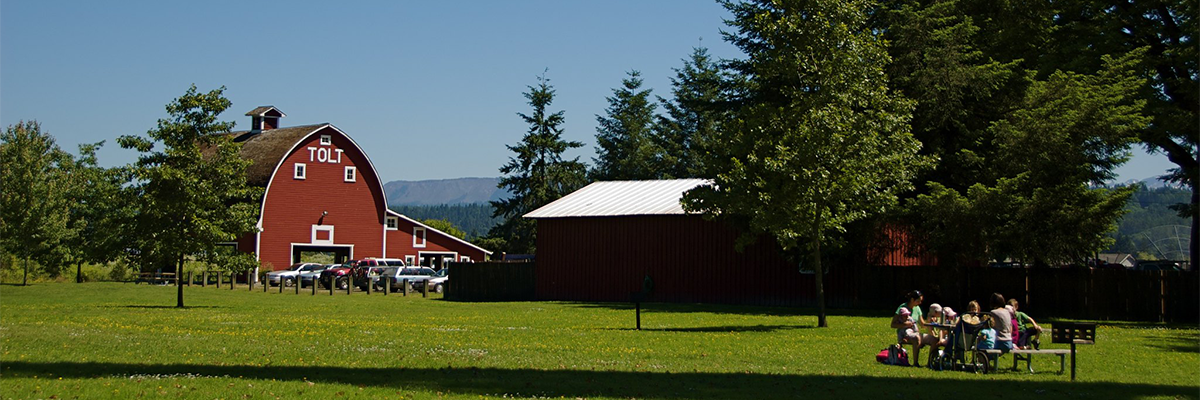Tolt MacDonald Park and Campground

About the Park
The 575-acre Tolt-MacDonald Park and Campground is located in Carnation at the confluence of the Snoqualmie and Tolt Rivers in the beautiful Snoqualmie Valley. Because this is high-quality salmon habit, during the fall, visitors can observe chinook salmon spawning in the river below while eagles and osprey soar above.
Beyond a 500-foot suspension foot bridge over the Snoqualmie River are twelve miles of forested and riverside trails connecting to an extensive network of trails in the adjacent Ames Lake Forest - a favorite mountain biking destination. For a bicycle tour of local farms, head in the opposite direction to access the 27-mile-long gravel Snoqualmie Valley Trail.
The park also features six yurts overlooking the river and seasonal camping for RVs, tents, and two large-group campsites - all with fire pits. There are also two large picnic shelters and a beautifully restored barn available for company picnics, weddings, and other special events.
Use our online reservation tool to reserve a camping spot, a ballfield, the barn, or the picnic shelter.
Tolt-MacDonald Park is the site of two popular annual events: the three-day Timber! Outdoor Music Festival and Beat the Blerch, a ridiculously fun running event.
Park activities and facilities
Amphitheater
Ballfield
Boat launch
Camp container
Camping site
Dog walking
Hiking
Nature observation
Mountain biking
Parking lot
Park office
Picnic shelter
Play equipment
Restrooms
Volunteer
Location
31020 NE 40th St, Carnation. Park entrance is at NE 40 St and SR-203 at the south end of Carnation.
Nearby Bus Stops
Tolt MacDonald Park is served by Snoqualmie Valley Transportation along SR-203 to Carnation.
Parking
Day-use and overnight parking is available on-site. No motorized vehicle access on west side of river other than service vehicles. Park opens at dawn. Gate locked nightly at 10 pm from May through Labor Day, and at dusk from September through April.
Trailheads
Trailheads for the upland forest trails are across the suspension bridge over the Snoqualmie River.
Park History
Prior to white settlement of the Snoqualmie Valley in the late 1850s, this area was home to several large permanent winter villages occupied by the ancestors of members of the Snoqualmie Tribe. Snoqualmie villages were along the Tolt, Snoqualmie, and Raging Riversand. The Snoqualmie people utilized many seasonal camps, as well as resource procurement and processing areas, between villages and in the surrounding uplands.
The town of Carnation was originally known as Grand Rapids, when it was established in the 1860s. Carnation was later called Tolt, as it developed around settler James Entwhistle’s claim to be its first settler. Tolt's economy centered on logging and agricultural pursuits, including hop farming, hay production, and dairy production, which expanded with arrival of the Great Northern and the Chicago, Milwaukee, and St. Paul Railroads in the early twentieth century. The town's name was changed from Tolt to Carnation in 1917, after the Carnation Milk Company. Then the name changed back to Tolt in 1928. But the post office and the railroad continued to be called Carnation and eventually Tolt reverted to Carnation in 1951.
King County bought the first publicly-owned parcels at what was to become Tolt River-John McDonald Park in the 1970s. The County developed the area, as envisioned by Boy Scout Council Chief John MacDonald who led local efforts in one of the nation's largest bicentennial projects. More than 20,000 Boy Scouts spent some five months constructing campsites, picnic tables, and shelters. The suspension bridge was also built at this time by the Army Reserves 409th Engineering Company. Today, it is a treasured historic property that is listed on the National Register of Historic Places. Tolt-MacDonald Park was dedicated upon completion of the project in June 1976.

 Translate
Translate